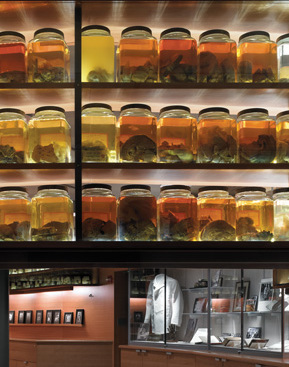 loading
loading
The brain cutter Christopher GardnerWhen the collection was restored, each jar was emptied, cleaned, refilled with new preservative, and sealed. At first, the liquid bathing the brains was clear. But the specimens soon leached out, and each jar took on its own individual glow. Cushing's white lab coat and a bronze model of his right hand are visible at the bottom of the photograph. View full imageA photograph survives of Harvey Williams Cushing as a Yale undergraduate in 1889, doing a perilous back flip off the stoop of a university building. It was one of the rare frivolous moments in an otherwise intensely purposeful life. Cushing, the product of three generations of physicians in a wealthy Cleveland family, performed surgery as a senior at Yale, extracting the brain of a dog found wandering on campus. (Notions of ethical experimentation, on animals and humans alike, were nebulous then, though as a doctor Cushing would at least anesthetize animals before operating on them, an indulgence some European counterparts deemed frivolous.) He went on to Harvard Medical School, and spent most of his career at Johns Hopkins Hospital in Baltimore, and later at Harvard’s Peter Bent Brigham Hospital in Boston, before eventually returning to Yale. In the late 1890s, when Cushing was starting out as a surgical resident, the skull was mostly “attacked in desperation and with dismal outcomes,” Michael Bliss writes in his 2005 biography Harvey Cushing: A Life in Surgery. Surgeons lacked imaging technologies to determine where in the brain a problem might lie, and they were ignorant about what neurological functions might be compromised by a careless move en route. Most attempts to operate ended ignominiously in bleeding, uncontrollable bulging of brain tissue, infection, and death. Young Cushing failed, too, with a pregnant woman shot in the head, and with a 16-year-old girl whose pituitary tumor eluded him in three attempts. These losses left him soul-shaken. But “having looked at the brain,” Bliss writes, Cushing went on in the first decade of the new century to learn “how to gain access to it, relieve it, and let it heal.” He thus became “the father of effective neurosurgery.” (“Ineffective neurosurgery,” Bliss adds, “had many fathers.”) Cushing himself attributed his success to meticulous care, rather than brilliant innovation. He prided himself on “perfection of anesthesia, scrupulous technique, ample expenditure of time, painstaking closure of wounds without drainage, and a multitude of other elements, which so many operators impatiently regard as trivialities.” The delicate nature of the work made slow going essential. “An operator who persists in taking dangerous curves at high speed will be the cause of a serious or fatal accident some day,” he declared, “whether he is driving an automobile or opening a skull.” Cushing worked “almost ritualistically,” according to Bliss, shaving and draping the patient’s head himself, and doing the routine closing of the wound afterwards. “He was especially pleased if there were no blood stains on the drapes when the operation ended.” Such care enabled him to go where other surgeons did not dare, and get far better results. Without adequate lighting or magnification, he reduced his mortality rate to less than 10 percent, in an era when renowned brain surgeons elsewhere admitted to losing a third to half their brain patients. But Cushing was also quick to invent surgical techniques and exploit new technologies. He introduced the blood pressure cuff to American medicine, after spotting the device in Italy during a year abroad, and he soon made it an essential tool for monitoring the status of surgical patients. He also adapted the idea of the inflatable cuff into a pneumatic tourniquet, wrapped around the skull before surgery to prevent heavy bleeding from the scalp. To control bleeding within the brain itself, he pioneered the use of silver surgical clamps in neurosurgery and also experimented with blood clots and living tissue to induce coagulation. Much later in his career, he introduced electrocauterization to brain surgery, using a pistol-shaped device that could cut and coagulate in the same motion. He described it as “powerful enough to electrocute a mastodon and pretty nearly as big.” It gave off the smell of burning tissue, produced shocks in early versions, and on one occasion lit up the operating room with a blue flare of ether vapor. But Cushing was thrilled at his newfound ability to remove large, heavily vascularized tumors: “I am succeeding in doing things inside the head that I never thought it would be possible to do.”
|
|